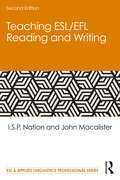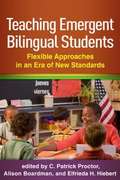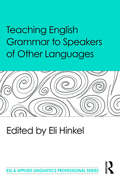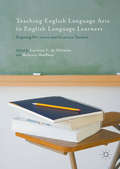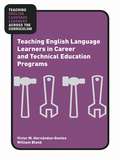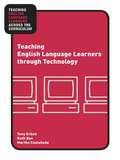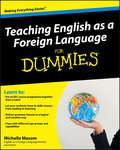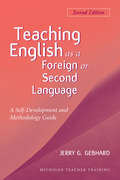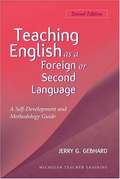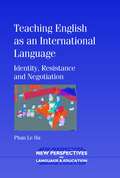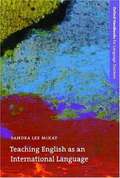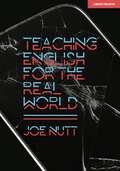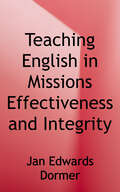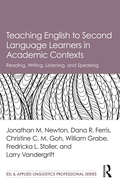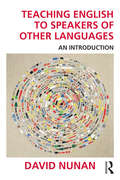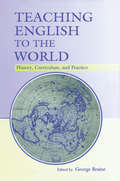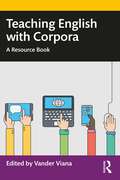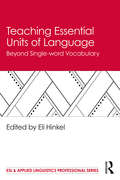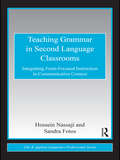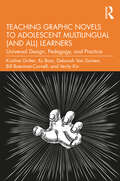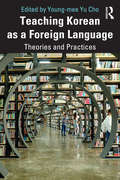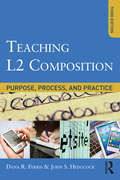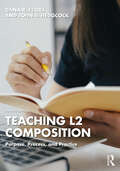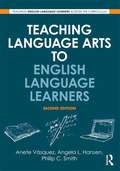- Table View
- List View
Teaching ESL/EFL Reading and Writing (ESL & Applied Linguistics Professional Series)
by John Macalister I.S.P. NationThe second edition of this bestselling text, Teaching ESL/EFL Reading and Writing, is a fully updated and expanded guide for teaching learners at all levels of proficiency how to develop their reading and writing skills and fluency. Practical and accessible, this book covers a diverse array of language teaching techniques suitable for all contexts. Updated with cutting-edge research and theory, the second edition is an essential and engaging text. Key insights and suggestions are organised around four strands – meaning-focused input, meaning-focused output, language-focused learning, and fluency development – to allow teachers to design and present a balanced programme for their students. Bringing together research and theory in applied linguistics and education, the text includes useful examples and practical strategies and features new topics related to technology, assessment, and genre. The second edition includes new tasks and further reading sections in every chapter. Teaching ESL/EFL Reading and Writing is designed for practising and pre-service teachers of all levels, and is ideal for certificate, diploma, masters, and doctoral courses in English as a second or foreign language.
Teaching Emergent Bilingual Students: Flexible Approaches in an Era of New Standards
by Elfrieda H. Hiebert Alison Boardman C. Patrick ProctorRecent educational reform initiatives such as the Common Core State Standards (CCSS) largely fail to address the needs--or tap into the unique resources--of students who are developing literacy skills in both English and a home language. This book discusses ways to meet the challenges that current standards pose for teaching emergent bilingual students in grades K-8. Leading experts describe effective, standards-aligned instructional approaches and programs expressly developed to promote bilingual learners' academic vocabulary, comprehension, speaking, writing, and content learning. Innovative policy recommendations and professional development approaches are also presented.
Teaching English Grammar to Speakers of Other Languages (ESL & Applied Linguistics Professional Series)
by Eli HinkelThis practical and research-based introduction to current and effective English grammar instruction gives pre-service and in-service teachers and teacher educators a strong foundation for teaching second language grammar and helps them develop their professional knowledge and skills. Written in a highly readable style for an international audience, it provides a thorough and rounded overview of the principles, strategies, techniques, and applications currently dominant in teaching L2 grammar in a range of instructional settings around the world. Chapter authors are world-class authorities in grammar and grammar teaching and learning. All chapters are based on theoretical frameworks and/or research foundations with a strong emphasis on practical applications and implications for classroom teaching, and highlight teaching methods, key concepts, and terminology associated with grammar instruction. Illuminating the options and choices in grammar teaching from a contemporary perspective, Teaching English Grammar to Speakers of Other Languages is ideal as key text for students in undergraduate and graduate MA-TESOL programs and as a resource for practicing ESL/EFL teachers, teacher educators, and teaching faculty.
Teaching English Language Arts to English Language Learners
by Luciana C. Oliveira Melanie ShoffnerThis book focuses on the ways in which English language arts (ELA) pre-service and in-service teachers have developed - or may develop - instructional effectiveness for working with English language learners (ELL) in the secondary English classroom. Chapter topics are grounded in both research and practice, addressing a range of timely topics including the current state of ELL education in the ELA classroom, and approaches to leveraging the talents and strengths of bilingual students in heterogeneous classrooms. Chapters also offer advice on best practices in teaching ELA to multilingual students and ways to infuse the secondary English teacher preparation curriculum with ELL pedagogy. Comprehensive in scope and content and examining topics relevant to all teachers of ELLs, teacher educators and researchers, this book appeals to an audience beyond ELA teachers and teacher educators.
Teaching English Language Learners in Career and Technical Education Programs
by Victor M. Hernández-Gantes William BlankExploring the unique challenges of vocational education, this book provides simple and straightforward advice on how to teach English Language Learners in today's Career and Technical Education programs. The authors' teaching framework and case studies draw from common settings in which career and technical educators find themselves working with ELLs—in the classroom, in the laboratory or workshop, and in work-based learning settings. By integrating CTE and academic instruction, and embedding career development activities across the curriculum, readers will gain a better understanding of the challenges of teaching occupationally-oriented content to a diverse group of learners in multiples settings.
Teaching English Language Learners through Technology
by Tony Erben Ruth Ban Martha CastañedaIn Teaching English Language Learners through Technology, the authors explore the use of computers/technology as a pedagogical tool to aid in the appropriate instruction of ELLs across all content areas. The special focus of this book is on the informed use of various technologies and software programs that can specifically aid ELLs. Strategies are also provided for varying levels of access--whether teachers teach in a one computer classroom, have access to multiple computers, or have the ability to go into a computer lab at their school. A fully annotated list of web and print resources completes the volume, making this a valuable reference to help teachers harness the power of computer-assisted technologies in meeting the challenges of including all learners in effective instruction.
Teaching English as a Foreign Language For Dummies
by Michelle MaxomMaking Everything Easier!Teaching English as a Foreign Language for DummiesLearn to:Put an EFL course programme together from scratchLet your students loose in skills classes - from reading to listeningDeliver grammar lessons in a logical and intuitive wayCope with different age groups and capabilitiesYour one-stop guide to a career that will take you placesIf you thought that teaching a language that's second nature to you would be easy, think again! Explaining grammar, or teaching correct pronunciation while simultaneously developing your own skills as a teacher can be a huge challenge. Whether you're on a training course or have already started teaching, this book will help launch your career and give you the confidence and expertise you need to be a brilliant teacher.Make an educated decision - decide between the various courses, qualifications and job locations available to youStart from scratch - plan well-structured lessons and develop successful and effective teaching techniquesFocus on skills - from reading and writing, to listening and speaking, get your students sounding and feeling fluentGet your head around grammar - teach students to put sentences together, recognise tenses and use adjectives and adverbsAll shapes and sizes - tailor your lessons to younger learners, one-to-ones, exam classes and Business English learners"An invaluable manual for anyone thinking of embarking on a TEFL journey. Michelle Maxom's step-by-step guide provides practical tips to get you started and offers key advice to help unleash the creative English language teacher within."--Claire Woollam, Director of Studies & a Teacher Trainer at Language Link LondonOpen the book and find:TEFL, TESOL, EFL - what all the acronyms meanThe best course books and materials to supplement your teachingAdvice on running your class and handling difficultiesLesson plans that you can use in the classroomActivities and exercises to keep your students on their toesConstructive ways to correct and assess your students' performanceWays to inject some fun into your classesInsider information on the best jobs around the world
Teaching English as a Foreign or Second Language: A Teacher Self-Development and Methodology Guide, Second Edition
by Gebhard Jerry G.Teaching English as a Foreign or Second Language, Second Edition, is designed for those new to ESL/EFL teaching and for self-motivated teachers who seek to maximize their potential and enhance the learning of their students. This guide provides basic information that ESL/EFL teachers should know before they start teaching and many ideas on how to guide students in the skills of listening, speaking, reading, and writing. It stresses the multifaceted nature of teaching the English language to non-native speakers and is based on the real experiences of teachers. The second edition of Teaching English as a Foreign or Second Language includes a wider range of examples to coincide with a variety of teaching contexts-from K-12 schools, to university intensive language programs and refugee programs. It is also updated with discussions of technology throughout, and it considers ways in which technology can be used in teaching language skills. Sources for further study are included in each chapter and in the appendixes.
Teaching English as a Foreign or Second Language: A Teacher Self-development and Methodology Guide
by Jerry G. GebhardTeaching English as a Foreign or Second Language, Second Edition, is designed for those new to ESL/EFL teaching and for self-motivated teachers who seek to maximize their potential and enhance the learning of their students. This guide provides basic information that ESL/EFL teachers should know before they start teaching and many ideas on how to guide students in the skills of listening, speaking, reading, and writing. It stresses the multifaceted nature of teaching the English language to non-native speakers and is based on the real experiences of teachers. The second edition of Teaching English as a Foreign or Second Language includes a wider range of examples to coincide with a variety of teaching contexts-from K-12 schools, to university intensive language programs and refugee programs. It is also updated with discussions of technology throughout, and it considers ways in which technology can be used in teaching language skills. Sources for further study are included in each chapter and in the appendixes.
Teaching English as an International Language
by Le Ha PhanBuilding on both Western and Asian theoretical resources, the book examines how EIL teachers see themselves as professional and individual in relation to their work practices. It reveals the tensions, compromises, negotiations and resistance in their enactment of different roles and selves, especially when they are exposed to values often associated with the English-speaking West. The ways they perceive their identity formation problematise and challenge the seemingly dominant views of identity as always changing, hybrid and fragmented. Their experiences highlight the importance of the sense of belonging and being, connectedness, continuity and a coherent growth in identity formation. Their attachment to a particular locality and their commitment to perform the moral guide role as EIL teachers serve as the most powerful platform for all their other identities to be constructed, negotiated and reconstituted.
Teaching English as an International Language
by Sandra Lee MckayThis series offers useful references for language teachers, teacher trainers, and trainees. English is the major language of international communication, and everyone wants to learn it. But which English, and how? This book provides an accessible overview of this increasingly important field.
Teaching English for the Real World
by Joe NuttSo much of the teaching in schools of how the English works does not prepare students for the real world. So little has changed in exams, the curriculum, or the way people think about English teaching, in several decades. This book is Joe Nutt's attempt to help schools redress that dramatic imbalance. It's not in any sense a practical teaching guide only for English teachers, nor is it full of hints and tips, lesson plans and schemes of work. Teaching English for the Real World is a far wider consideration of what schools and English teachers should be doing if they wish to prepare secondary school children to be successful and effective users of English, in the real world of work, higher education and adult life they will all too soon enter. If you are an English teacher, by the time you finish reading Teaching English for the Real World, you should be better prepared to deliver lessons that those you teach will forever be grateful for. The book consists of four main sections: English in context, towards the GCSE, choosing texts and technology matters. It starts by putting English clearly into context through a range of current examples. It urges teachers to consider the complex role English usage plays on everything from the side of a bus, through tissue-thin social media, garish slideshows and perky TED talks, to the hundreds of pages of research or official reports so often used as the basis for serious political policy and commercial decision making. It will then examine the classroom status quo and instead of the unrealistic and damaging focus on experiment and creativity, instead of requiring them to write newspaper articles, stories or speeches, the main deliverables in any English GCSE exam, the book will argue that teachers should think carefully about how to connect what children write, with who they are and where they really want to publish. The next section deals with choices of texts. There is a place for children to be taught to write well by example, but there are challenging questions to ask about much of the material routinely chosen. How often are texts and authors selected for study, for reasons that have absolutely nothing whatsoever to do with knowledge or linguistic skill, and everything to do with politics? Even exam boards are guilty of this. The final section examines the relationship between English and the technology real people use to produce it. It reflects on how technology has impacted on the quality of the reading experience itself and argue that there is a crisis in reading in secondary schools, with many children sailing through exams yet leaving school as disinterested and even poor readers. And it suggests how teachers might approach introducing these different risks to children and equip them best to make sound judgements about the way they write and communicate, for personal and employment purposes in adult life.
Teaching English for the Real World
by Joe NuttSo much of the teaching in schools of how the English works does not prepare students for the real world. So little has changed in exams, the curriculum, or the way people think about English teaching, in several decades. This book is Joe Nutt's attempt to help schools redress that dramatic imbalance. It's not in any sense a practical teaching guide only for English teachers, nor is it full of hints and tips, lesson plans and schemes of work. Teaching English for the Real World is a far wider consideration of what schools and English teachers should be doing if they wish to prepare secondary school children to be successful and effective users of English, in the real world of work, higher education and adult life they will all too soon enter. If you are an English teacher, by the time you finish reading Teaching English for the Real World, you should be better prepared to deliver lessons that those you teach will forever be grateful for. The book consists of four main sections: English in context, towards the GCSE, choosing texts and technology matters. It starts by putting English clearly into context through a range of current examples. It urges teachers to consider the complex role English usage plays on everything from the side of a bus, through tissue-thin social media, garish slideshows and perky TED talks, to the hundreds of pages of research or official reports so often used as the basis for serious political policy and commercial decision making. It will then examine the classroom status quo and instead of the unrealistic and damaging focus on experiment and creativity, instead of requiring them to write newspaper articles, stories or speeches, the main deliverables in any English GCSE exam, the book will argue that teachers should think carefully about how to connect what children write, with who they are and where they really want to publish. The next section deals with choices of texts. There is a place for children to be taught to write well by example, but there are challenging questions to ask about much of the material routinely chosen. How often are texts and authors selected for study, for reasons that have absolutely nothing whatsoever to do with knowledge or linguistic skill, and everything to do with politics? Even exam boards are guilty of this. The final section examines the relationship between English and the technology real people use to produce it. It reflects on how technology has impacted on the quality of the reading experience itself and argue that there is a crisis in reading in secondary schools, with many children sailing through exams yet leaving school as disinterested and even poor readers. And it suggests how teachers might approach introducing these different risks to children and equip them best to make sound judgements about the way they write and communicate, for personal and employment purposes in adult life.
Teaching English in Missions: Effectiveness and Integrity
by Jan Edwards DormerEnglish Teaching is common in missions today. However, there has been relatively little discussion on what constitutes effectiveness in English ministries. <p><p>This book aims to foster such discussion. It first addresses issues of concern in English ministries and then suggests criteria for effectiveness, considerations in teacher preparation, and models for the teaching of English in missions.
Teaching English to Second Language Learners in Academic Contexts: Reading, Writing, Listening, and Speaking (ESL & Applied Linguistics Professional Series)
by William Grabe Dana R. Ferris Fredricka L. Stoller Larry Vandergrift Jonathan M. Newton Christine C.M. GohTeaching English to Second Language Learners in Academic Contexts: Reading, Writing, Listening, and Speaking provides the fundamental knowledge that ESL and EFL teachers need to teach the four language skills. This foundational text, written by internationally renowned experts in the field, explains why skills-based teaching is at the heart of effective instruction in English for academic purposes (EAP) contexts. Each of the four main sections of the book helps readers understand how each skill—reading, writing, listening, and speaking—works and explains what research has to say about successful skill performance. Pedagogically focused chapters apply this information to principles for EAP curriculum design and to instructional activities and tasks adaptable in a wide range of language-learning contexts. Options for assessment and the role of digital technologies are considered for each skill, and essential information on integrated-skill instruction is provided. Moving from theory to practice, this teacher-friendly text is an essential resource for courses in TESOL programs, for in-service teacher-training seminars, and for practicing EAP teachers who want to upgrade their teaching abilities and knowledge bases.
Teaching English to Speakers of Other Languages: An Introduction
by David NunanDavid Nunan's dynamic learner-centered teaching style has informed and inspired countless TESOL educators around the world. In this fresh, straightforward introduction to teaching English to speakers of other languages he presents teaching techniques and procedures along with the underlying theory and principles. Complex theories and research studies are explained in a clear and comprehensible, yet non-trivial, manner without trivializing them. Practical examples of how to develop teaching materials and tasks from sound principles provide rich illustrations of theoretical constructs. The content is presented through a lively variety of different textual genres including classroom vignettes showing language teaching in action, question and answer sessions, and opportunities to 'eavesdrop' on small group discussions among teachers and teachers in preparation. Readers get involved through engaging, interactive pedagogical features and opportunities for reflection and personal application. Each chapter follows the same format so that readers know what to expect as they work through the text. Key terms are defined in a Glossary at the end of the book. David Nunan's own reflections and commentaries throughout enrich the direct, up-close style of the text.
Teaching English to the World: History, Curriculum, and Practice
by George BraineTeaching English to the World: History, Curriculum, and Practice is a unique collection of English language teaching (ELT) histories, curricula, and personal narratives from non-native speaker (NNS) English teachers around the world. No other book brings such a range of international ELT professionals together to describe and narrate what they know best.The book includes chapters from Brazil, China, Germany, Hong Kong, Hungary, India, Indonesia, Israel, Japan, Lebanon, Poland, Saudi Arabia, Singapore, Sri Lanka, and Turkey. All chapters follow a consistent pattern, describing first the history of English language teaching in a particular country, then the current ELT curriculum, followed by the biography or the autobiography of an English teacher of that country. This consistency in the structuring of chapters will enable readers to assimilate the information easily while also comparing and contrasting the context of ELT in each country.The chapter authors--all born in or residents of the countries they represent and speakers of the local language or languages as well as English--provide insider perspectives on the challenges faced by local English language teachers. There is clear evidence that the majority of English teachers worldwide are nonnative speakers (NNS), and there is no doubt that many among them have been taught by indigenous teachers who themselves are nonnative speakers. This book brings the professional knowledge and experience of these teachers and the countries they represent to a mainstream Western audience including faculty, professionals, and graduate students in the field of ESL; to the international TESOL community; and to ELT teachers around the world.
Teaching English with Corpora: A Resource Book
by Vander VianaTeaching English with Corpora is an accessible and practical introduction to the ways in which online and offline corpora can be used in English language teaching (ELT). Featuring 70 chapters written by an international range of researchers and practitioners, this book: • provides readers with clear, tested examples of corpus-based/driven lesson plans; • contains activities relevant to English for general purposes and English for specific purposes; • caters for the needs of English language teachers working with learners at different proficiency levels; • features flexible teaching suggestions that can be explored as part of a lesson or as a full lesson. This book is an essential purchase for pre- and in-service English language teachers as well as those studying corpus linguistics in undergraduate/Master’s courses in applied linguistics, ELT and Teaching English to Speakers of Other Languages (TESOL).
Teaching Essential Units of Language: Beyond Single-word Vocabulary (ESL & Applied Linguistics Professional Series)
by Eli HinkelThis textbook provides a practical and research-based foundation for teaching second language (L2) multiword units (also commonly called collocations). Multiword units – such as strong tea, beautiful weather, or would you mind –cannot be readily understood or predicted by the meanings of their component parts, and prove particularly challenging for English language learners. With contributions from top scholars, this text presents a thorough and rounded overview of the principles and practices currently dominant in teaching L2 phrases in a variety of instructional settings around the world. Divided into two sections, Part I examines the pedagogical foundations of teaching the essential units of language. Part II covers a range of techniques and classroom activities for implementing instruction. Intended for students and teacher educators, this accessible volume integrates the key principles, strategies, and applications of current and effective English language instruction for both vocabulary and grammar.
Teaching Grammar in Second Language Classrooms: Integrating Form-Focused Instruction in Communicative Context
by Hossein Nassaji Sandra S. FotosRecent SLA research recognizes the necessity of attention to grammar and demonstrates that form-focused instruction is especially effective when it is incorporated into a meaningful communicative context. Designed specifically for second-language teachers, this text identifies and explores the various options for integrating a focus on grammar and a focus on communication in classroom contexts and offers concrete examples of teaching activities for each option. Each chapter includes a description of the option, its theoretical and empirical background, examples of activities illustrating in a non-technical manner how it can be implemented in the classroom, questions for reflection, and a list of useful resources that teachers can consult for further information.
Teaching Graphic Novels to Adolescent Multilingual (and All) Learners: Universal Design, Pedagogy, and Practice
by Kristine Gritter Xu Bian Deborah Van Duinen Bill Boerman-CornellThis book provides a roadmap for teaching with graphic novels as an effective and engaging approach to advancing reading comprehension for English Learners in secondary schools. Accessibly synthesizing and presenting existing graphic novel research, the authors walk through how to use graphic novels as a teaching tool to improve student motivation and key reading skills, increase their reading proficiency levels, and bolster their vocabulary. The authors provide curricular ideas for teaching multilingual, gifted, and striving readers, along with methods for developing critical literacy and multimodal comprehension. Applying a universal design approach and including examples, current graphic novel recommendations, and pedagogical strategies, this book is essential reading for pre-service teachers in TESOL and literacy education.
Teaching Korean as a Foreign Language: Theories and Practices
by Young-mee Yu ChoTeaching Korean as a Foreign Language: Theories and Practices is designed for prospective or in-service Korean as a Foreign Language (KFL) teachers. With contributions from leading experts in the field, readers will gain an understanding of the theoretical framework and practical applications of KFL education in the context of Second Language Acquisition (SLA). The eight chapters explore the history of and current issues in language education, the practicalities of being a classroom teacher, and teaching and evaluation techniques for developing language and cultural proficiency. This comprehensive volume also includes an annotated bibliography which lists over 500 of the most recent and pertinent research articles and doctoral dissertations in the area. This bibliography will be of great service to students, teachers, and any researchers in applied linguistics and second language acquisition interested in Korean language education.
Teaching L2 Composition: Purpose, Process, and Practice
by Dana R. Ferris John HedgcockThis popular, comprehensive theory-to-practice text is designed to help teachers understand the task of writing, L2 writers, the different pedagogical models used in current composition teaching, and reading–writing connections. Moving from general themes to specific pedagogical concerns, it includes practice-oriented chapters on the role of genre, task construction, course and lesson design, writing assessment, feedback, error treatment, and classroom language (grammar, vocabulary, style) instruction. Although all topics are firmly grounded in relevant research, a distinguishing feature of the text is the array of hands-on, practical examples, materials, and tasks that pre- and in-service teachers can use to develop the complex skills involved in teaching second language writing. Each chapter includes Questions for Reflection, Further Reading and Resources, Reflection and Review, and Application Activities. An ideal text for L2 teacher preparation courses, courses that include both L1 and L2 students, and workshops for instructors of L2 writers in academic (secondary and postsecondary) settings, the accessible synthesis of theory and research enables readers to see the relevance of the field’s knowledge base to their own present or future classroom settings and student writers.
Teaching L2 Composition: Purpose, Process, and Practice
by Dana R. Ferris John S. HedgcockThis popular, comprehensive theory-to-practice text helps teachers understand the task of writing, L2 writers, the different pedagogical models used in current composition teaching, and reading-writing connections. Moving from general themes to specific pedagogical concerns, it includes practice-oriented chapters on the role of genre, task construction, course and lesson design, writing assessment, feedback, error treatment, and classroom language (grammar, vocabulary, style) instruction. Each chapter includes Questions for Reflection, Further Reading and Resources, Reflection and Review, and Application Activities. An ideal text for L2 teacher preparation courses and in-service writing instructors, the text offers an accessible synthesis of theory and research that enables readers to see the relevance of the field’s knowledge base to their own present or future classroom settings and student writers. New to the Fourth Edition: Updated with new research, theory, and developments in the field throughout the text Visually accessible layout and design for improved reader navigability Expanded attention to technological affordances for writing pedagogy Stand-alone reference list in each chapter Support Material with activities and resources from the text also available on the book’s webpage at www.routledge.com/9780367436780
Teaching Language Arts to English Language Learners
by Anete Vásquez Angela L. Hansen Philip C. SmithThis thoroughly revised and updated edition of Teaching Language Arts to English Language Learners provides readers with the comprehensive understanding of both the challenges that face ELLs and ways in which educators might address them in the language arts classroom. The authors offer proven techniques that teachers can readily use to teach reading, writing, grammar, and vocabulary as well as speaking, listening, and viewing skills. A complete section is also devoted to ways teachers can integrate all five strands of the language arts curriculum into a comprehensive unit of study with meaningful accommodations for ELLs. An annotated list of web and print resources completes the volume, making this a valuable reference for language arts teachers to meet the challenges of including all learners in effective instruction. New features to this edition include: An updated and streamlined Part 1, which provides an essential overview of ELL theory in a language arts specific context. Additional practical examples of language arts exercises, all of which are closely aligned with the Common Core State Standards. New pedagogical elements in Part 3, including tips on harnessing new technologies, discussion questions and reflection points. Updates to the web and print resources in Part 4
